In this issue of the eLife podcast we discuss how chimpanzees use conceptual metaphors, the hyperactivation of spermatozoa, the use of bacteria to estimate the time of death, stem cells and smoking, and a new type of bacteria.
In this episode
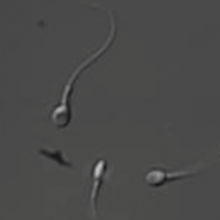
01:16 - Ion channels and human sperm
Ion channels and human sperm
with Nadja Mannowetz, University Hospital in Essen
We know from work in mice, that sperm use certain ions like potassium, 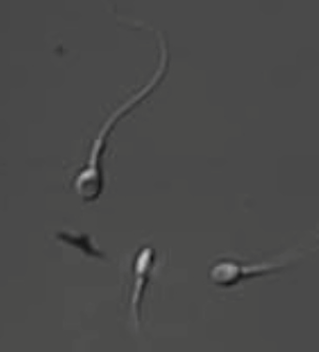 to control their activity. And while ion channels to admit potassium have been found in mice, no one had found the human equivalent until now.
to control their activity. And while ion channels to admit potassium have been found in mice, no one had found the human equivalent until now.
Nadja - We wanted to identify a potassium-iron channel in humans spermatozoa. Sperm are highly differentiated cells and their task is to carry genetic material of the father, fuse with the egg, and produce offspring. And to do that, they depend on several chemical compounds such as electrolytes, sodium, potassium, calcium, magnesia. These compounds cannot enter or leave the cell just as they want. Sperm cells have to have pores in their membrane, and these pores, we call ion channels. Two of such ion channels have been identified, a calcium channel, the other is a proton channel and both of these channels are dependent on membrane potential. And the membrane potential is being set by potassium ion channels. For mice, the identity of a potassium channel has been characterised, but such data were not available for human sperm.
Chris - So, we know that there has to be a potassium channel on the human sperm because we know it's there in mice, and it's fundamental to how the mouse sperm does its job. So, the question is, what is it and how does it work, can we identify it?
Nadja - Exactly. We addressed this question to apply the so-called 'patch clamp' technique to the cells. This is an electrophysiological technique. You record electrical currents of the cell, which gives you an answer - is there an active potassium channel present in these cells? By applying specific inhibitors, you can then fingerprint the pharmacological profile.
Chris - So, you took some human sperm and you applied this patch clamp technique which enabled you to study how ions were going back and forth, in and out of the sperm. And you've been able to identify what must be a potassium channel on the human sperm. Is it the same as the one that we find in mice?
Nadja - No, it's a totally different channel. The potassium channel in mouse sperm is called the SLO3 channel, and this channel is activated when the intracellular pH rises. In human sperm, changes of intracellular pH do not activate the potassium channel. In human sperm, changes of intracellular calcium activate the channel.
Chris - So, this must be some kind of evolutionary solution to the way that human and mouse mating habits differ.
Nadja - Yes. It could also be, if we'd look on the genes for that SLO3 channels in mice and the so-called SLO1 channel in humans, they share a certain amount of homology. It's about 50 or 60%, and you could think that at some point during evolution, mice and humans diverged from each other.
Chris - So, what are the implications of finding this new potassium channel? Does this open up a new ability for us to manipulate the behaviour of sperm or the activity of sperm, and does it also explain why some people can't get pregnant?
Nadja - Yes. Identifying an ion channel helps to understand how male fertility works. So having identified SLO1 as the principal potassium in human sperm, it might open up research on a genetic level to screen men, whether they have a genetic defect in the SLO1 coding gene, and then think about perhaps about a proper treatment.
Chris - And looking at the flip side of the coin, what about contraception?
Nadja - Yeah. This is a very good point when you try to solve questions, what could cause male infertility. You could also think about developing a male contraceptive. The findings, we have published could be the basis to develop a male contraceptive but I have to say, if you want to develop a male contraceptive, you have to make sure that this drug only affects sperm or developing sperm cells, and not other cells of the body. SLO1 has been shown to be expressed and conduct potassium ions in nerve cells as well as in muscle cells.
Chris - So, that means then that it would be quite difficult to come up with a discrete blocker unless you used or exploited some other function of the sperm to target that.
Nadja - Exactly.
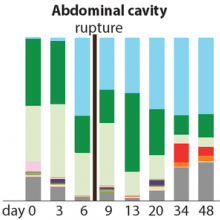
07:00 - Bacteria and forensic science
Bacteria and forensic science
with Jess Metcalf, University of Colorado, Boulder
Forensic scientists have range of techniques to work out how long a person has been dead. These include looking at things like insects that may have moved in to help decomposition along. Unfortunately, these measures are fraught with difficulties and they tend to be quite inaccurate. But now, University of Boulder, Colorado, scientist Jess Metcalf has been looking at another potentially much more accurate way of doing it. She's looking at the communities of microorganisms that grow in and on the body...
Jess - So, we know microbes play an important role in decomposition, that's no secret. Forensic scientists have known this for a long time. However, we haven't had the tools to really study the microbes and because decomposition is driven by biological processes, forensic scientists try to use biological information to estimate the time since death. For example, if you watch CSI or some similar program, you might always see a forensic scientist sampling blue fly larvae. Oh, it's at this stage this means that this body could have only been dead for so long and so our question was, can we use microbes to try to answer the same type of question? Because every approach in forensic science for estimating the time since death, they all have some amount of uncertainty around them, and if you combine these different approaches, you can narrow that window of uncertainty. And our question is, can we use the information about microbial community change during decomposition to help narrow this window?
Chris - Why should that be better than what the other measures can already offer, Jess?
Jess - Every type of approach has its limitations. So, for example, body temperature and really, that's only going to be relevant in the first 48 hours. And then things like the succession of insects might be limited by the seasons. So, sometimes in the winter, insects never show up at a body. So, you can't use that. However, we all have microbes in us and on us when we're alive, and so, we already have the organisms at the time of death.
Chris - It's like our own an in-built biomarker. So, how did you do this?
Jess - We used a mouse model system. And the reason we did that is that because really, what this question is about is if you have lots of replicates. Are you going to see the same microbial community change in each replicate or is it some stochastic response of the microbial community? What we want it to be, to be able to use it as sort of a biomarker to estimate the time since death is, we want it to be consistent across replicates. And that's really hard to do in using, for example, donated human corpses or even, what's often used in forensic sciences, is a swine model. Those experiments are usually limited to one to three individuals. And so, with a model system, like a mouse model system, we were able to use 40 individuals and we sampled 5 at a time over 8 time points. And this was the first time, someone was able to characterize that bacterial community change.
Chris - Could you also look, not just in the body, but in the environment because the body, by virtue of breaking down, is going to release various chemicals and nutrients into the surrounding environment, that which will in turn, surely alter the microbial communities there too?
Jess - That's a great question. And that's one of the things that we looked at in this study - how decomposition of a corpse affects the surround soil. Often times, you know, in a crime scene, you'll find a body on the soil outside and so, if someone moves a body, can we test the soil and say that something was decomposing on it? And so, for the soil, we're kind of interested in two different questions. One, can we also use the change in soil microbes to estimate the time since death? But also, is there a really significant signature left by the decomposition process? And the answer to both of those questions was, yes. Then at every site, we saw really significant change, in both the bacteria and sort of the nematodes and other microbial eukaryotes that were present. Everything changed very significantly.
Chris - How were you measuring the microbes? Was this using a DNA technique?
Jess - Exactly. So, what we did is we borrowed the techniques that are now more commonly used to really understand the human gut microbiome and take a sample at the depths of like millions of sequences, then characterized the community of bacterial species and the community of, say fungi and nematodes that are present.
Chris - But obviously, where the majority of the bugs are in a human is inside us, in our guts. And so, that's going to really strongly dictate what we then get rotted down by, at least initially, isn't it? So, does it make a difference to your assay do you think, or will it, whether you got a person from one culture or another culture, one sex or a different sex, because we all know that our microbial spectrum is as unique as a fingerprint? (We're not all)(12:15) you genetically identical study mice. So, will it still work in a highly genetically diverse and microbiologically diverse human population?
Jess - That's a really good question, and that's what our follow up experiments are getting at. Now, we're going to look across different host species. So, obviously, mice have different gut microbes than pigs or swine than do humans, and so, one of the things we're going to do with all our different studies is then compare across different host organisms or species. Does that influence what your decomposer community looks like? And that sort of gets at the same question of like, different diets and different sort of gut microbiomes.
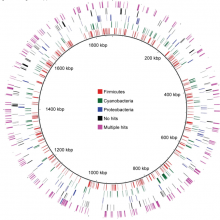
12:57 - Introducing: the Melainabacteria...
Introducing: the Melainabacteria...
with Sara Di Rienzi, Cornell
Meet a newly-described bacterial family known as melainabacteria, which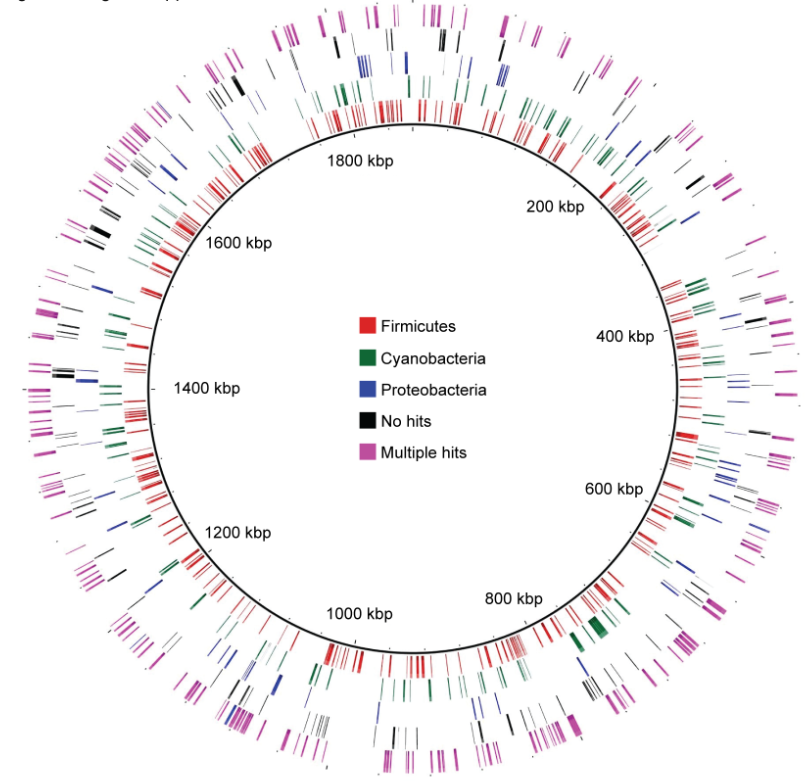 had previously been written off as cyanobacteria until Sara Di Rienzi came along...
had previously been written off as cyanobacteria until Sara Di Rienzi came along...
Sara - It's been known for a while, that within the human gut there are sequences that appear to be very closely related to cyanobacteria. So closely related that they're generally just assumed to actually belong to cyanobacteria. So, whenever these sequences pop up, they just automatically are assigned as cyanobacteria when they're not. And where this really gets confusing is that cyanobacteria are photosynthetic, so they like to be in places where there's light. That's how they live, that's how they get their energy.
Chris - And where you're looking, naturally the sun doesn't shine terribly often.
Sara - Exactly, there's no light in the human gut.
Chris - Well not on a good day anyway.
Sara - Yeah, exactly. So, when most people read, "Oh, cyanobacteria in the human gut," they say to themselves, that must be the plants we've been eating. It must be from the photosynthetic cells that are contained within plants and not that this is some cyanobacteria that's actually growing in the human gut. So, what we were setting out to do is to try to actually determine, well, what exactly are these bacteria? And our lab has tried for some time to actually grow them in the lab and this has proved to be very difficult and unsuccessful. What we did was complete sequencing of faecal samples. I worked specially in collaboration with Itai Sharon, who's a post-doc in Jill Banfield's lab. And they have this really amazing technique which allows them to sift through a pool of DNA sequences and figure out who belongs to who. So, what the method expects is that DNA that comes from one organism should all be in about the same amount, whereas DNA that comes from another organism should be in a completely different amount.
Chris - I get it, and so you can begin to assemble the bits of DNA that go together based on the frequency of those components. What did that tell you?
Sara - So, what that allowed us to do is to get all the DNA that belonged to this weird cyanobacteria light organism all together, and then from there, we could go and use traditional characterisation of genomes based on information we've learned by studying thousands of other bacteria over the years.
Chris - And then it became patently clear this was not a cyanobacteria and this was something else?
Sara - Yes. First, we firmly established that this is absolutely not a cyanobacteria.
Chris - So, what actually is it, and what does it do, and why is it there?
Sara - So, we've termed this new group of bacteria, melainabacteria, and we've discovered that it's entirely non-photosynthetic. So, it's very different metabolically from cyanobacteria, and instead it's entirely anaerobic and it uses fermentation to get its energy. So, that means it's breaking down sugars.
Chris - But given its stark differences to cyanobacteria, why is it that at the same time so similar to them?
Sara - Right. So, there's a specific gene, the 16S ribosome, this is the best marker we have to understand evolution. And so, by following that, we see that it is closely related to cyanobacteria. So, what we hypothesise is that at one point there was a general ancestor, and that then it either went off into the light, so to speak, and figured out how to use light for energy, or it ended up burying itself in dark places like the human gut. In those environments, it had to just rely on fermentation entirely.
Chris - So, if we look outside the human gut, where else would we find this organism, this family, and what sorts of things does it do in the environment or in other environments other than in us?
Sara - So it's also found in water systems. We specifically were able to sequence one out of an aquifer. What exactly it does, we're not 100% certain of. We have some ideas of what it does in the human gut. We're assuming metabolic similarities to a group of organisms called, firmicutes. So, firmicutes act as major fermenters in the large intestine where they break down sugars and can convert them to short chain fatty acids, and we think these melainabacteria can carry out a similar process.
Chris - So, any evidence that they may be linked to pathology, or are they thought to be just passengers that are harmless.
Sara - Yeah. We think they're actually if anything, beneficial. They're also able to produce the B and K vitamins which the host does need to get from its gut bacteria, and there's some evidence, based on its interactions with the immune system, that it would not be a pathogen.
Chris - So, what questions now remain outstanding? You've found this organism. You've proved what people have missed all along, but now, what are you going to do?
Sara - Oh. We'd love to know what it looks like. We haven't seen what a cell of it looks like, yet.
Chris - So, apart from trying to grow it and look at it so you can have pretty pictures of it, and publish the first EM of whatever this is, what else are the big questions you're going to ask of it genetically and evolutionarily speaking?
Sara - So, we'd like to get a better idea of why it's enriched in herbivores, for instance. Some of our findings is that it's enriched in mammals that are herbivores.
Chris - Does that include human vegetarians?
Sara - Unfortunately, there's not enough data for us to be able to really answer that question. However, we were able to compare humans living in more western cultures versus those in Venezuela and in Africa, and we found that they are more present in the people from South America and from Africa, which are also on more vegetarian diets. But we don't have that 100%, "Yes. If you eat your vegetables, you'll end up with melainabacteria in you."
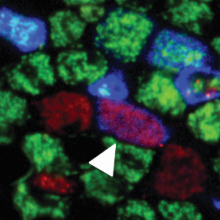
19:13 - Stem cells and smoking
Stem cells and smoking
with Sam Janes, UCL
Where do the cells lining the airway arise, and how does smoking affect them? A study recently carried out indicates that the airways of smokers age twice as quickly as non-smokers, having serious consequences for their health.
Sam - So, my name is Sam Janes, and I'm working as a Wellcome Senior fellow at University College London. For some time, many have felt that the organs of our body rely on stem cells to repopulate all the cells in our organs when we need them. So, these stem cells should be capable of producing daughter cells of lots of different types. Now, most of this has come from data from mice, where it's possible to track individual cells over time, but this has never been possible in humans. So, we were looking to see whether stem cells really existed in the airways, and in the lungs, there are cells that secrete mucus, there are cells that have little cilia on them, and there are basal cells which are chunky little cells which sit right at the bottom on what we call the basement membrane, which is like the pavement of the lining of the airways.
Chris - And those chunky cells, are they the stem cells?
Sam - From mice, it has been felt that basal cells are stem cells of the airways. So, I suppose that was what we were expecting to see with our work.
Chris - And now, tell us how you actually did this?
Sam - It's quite a challenge in humans, because what we actually need to do this, is to be able to see a stem cell and then see how it divides and look at what we would call it's daughter cells to see what type of cells they are. And to do that in a human, is pretty well impossible on any internal organ in particular. But what we found was that there was a scientist, Sir Nicholas Wright at Barts and the London, and he had worked on a way of staining and seeing individual cells for an enzyme that was produced by the mitochondria within our cells. And what he found actually was if this mitochondria had some sort of genetic mutation, which just actually occurs by chance. If those mutations collected, eventually an individual cell would stop expressing that enzyme. Now that means that with this stain, you can see that cell and you can also see daughter cells which have come from that individual mutation.
Chris - Because they also carry the same mutation and therefore, will have the same funny staining pattern.
Sam - Exactly.
Chris - So, you can use this unique labelling of cells in order to track individual lineages of cells.
Sam - That's right. So, when we look down the microscope at these cells, so these are in patients that have undergone some sort of lung surgery and had an area of lung taken out. We put the stain on so we can see these cells that are lacking the enzyme, and when we actually pluck out these cells individually and test their DNA, we can prove that they are indeed all related.
Chris - And returning to the question you started with, which is what do these stem cells turn into? What do you find when you examine all of those clones of cells that have come from one source stem cell?
Sam - Well, what we found was actually pretty interesting. So, the individual clones of cells were all identical and within them, they had lots of different cell types. But there were two really important things. One, was that every cluster had a basal cell, whereas other cells were sometimes missing from these clusters. So, that means that the basal cells are indeed the progenitor cells, but what was really intriguing was that when we showed the results to a mathematician in Cambridge called Ben Simons, he looked at these and said, actually these aren't related and in fact, what these clones are doing is entirely by chance. So, in fact these aren't preprogrammed stem cells that are doing a particular job but in fact, basal cells that are just dividing by chance and so they may divide to reproduce themselves, they may divide to become a different type of cell type, or they may just die.
Chris - So, what are the implications of this?
Sam - There are a number of implications. The first is, as many of us know, there's a great deal of research looking at regeneration of organs and there's been a feeling that you must get the stem cells and understand what the stem cells of an organ are, to be able to regenerate it. Our data from the airways of humans suggests that that isn't the case - you simply need to collect a broad population of these basal cells. The second thing that was quite interesting was that we looked at non-smokers and compared them to smokers, and what we found in smokers was that the whole process is basically speeded up by two. Now this is quite important because, one, it suggests that the airways of smokers are aging twice as quickly as they should, but the second thing is, these clones are expanding twice as quickly. So, if you ended up with a clone with genetic mutation which may contribute to forming a cancer, then that clone is already spreading twice as quickly.
Chris - But going back to your method, is it possible that what you're seeing is an artefact of the fact that the cells have a mutation?
Sam - Yes. So, that's a really important point because you're quite right. If the mutation led to some sort of advantage for these cells, then they may be expanding more quickly than we would expect. But, quite a lot of work has been done with these mitochondrial mutations, and these mutations aren't thought to effect the way the cells proliferate or survive at all.
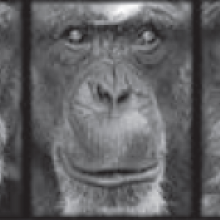
25:05 - Chimps use conceptual metaphors
Chimps use conceptual metaphors
with Ikuma Adachi, Kyoto University
Why do we use phrases like, "Top-tier", or "Underclass" when we're considering 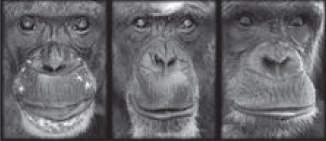 our peers? Some people think it's because we have language, and therefore, we use verbal metaphors as a convenient way to map priority social position. But then, what would happen if you asked a chimpanzee, which of course, can't talk?
our peers? Some people think it's because we have language, and therefore, we use verbal metaphors as a convenient way to map priority social position. But then, what would happen if you asked a chimpanzee, which of course, can't talk?
Ikuma - What we tried to find is the evolutional origin of the language, and especially when we use a word - high, low - those wordings can be everything, right? The price, is it high and low? In space, of course, it's high, low. So, why does this happen? We tackled this phenomenon in no human animals because this phenomenon is often argued in a context of a language evolution. Because we evolved this language system, we have this systematic mapping.
Chris - So, this would be like a sort of social pecking order, there's another metaphor, isn't it, where you've got people who are regarded as the "top of the tree" and the person who's at the "bottom of the tree", or premium price versus bargain basement? You're saying that we have those metaphors only because we have words for them?
Ikuma - That's what a lot of people actually believe, and what we raise the question here, is it really so? This might reflect small simple another mechanism to reduce the information processing. So in that case, other species should also have this kind of a connection. So that's what we try to reveal first.
Chris - So, your argument would be then that actually having that concept of high and low social pecking order, or whatever, comes first, there's some kind of neurological correlate for that and we humans just adopted some words to put that into words. Whereas other animals, simpler animals, that may not have language nonetheless would have that kind of construct still of a concept of things being higher or lower than others.
Ikuma - Right, exactly.
Chris - So, how on Earth can you probe that?
Ikuma - So, what I did is quite a simple approach, asking them if no human primate chimpanzee also have this kind of mapping or not. So, we tested six chimpanzees and what we did is show one picture first of the certain individual whom is familiar to the subject and then it's gone, and then two pictures come up to the screen, and then they have to choose who is the same individual. Arrangement of this choice is actually vertically organised, which means sometimes high-rank individual were located in the high place, but sometime low-rank individuals were located in the high place, and we don't ask actually rank of the individual but whenever they are looking for high rank or low rank individuals, which position fit to their representation. If it's much to their feeling, then that should be easier, but if it's not fitting, then it's going to be a little difficult than the fitting situation.
Chris - So, do you see a delay coming in then - when you put in the order the wrong way around, the lower ranking individual is higher up the screen? Do they take longer to choose that one as the one they saw previously, whereas if you get someone, an individual from their group who they recognise as being top of the tree and you put them at the top, they get it straight away?
Ikuma - Right, that's exactly the case.
Chris - Why do you think they do that? What's the reason for this?
Ikuma - What I think is it's more efficient for the living creature to understand information in the analogy of the space, for example. So, using some similar features to connect the multi-dimensional information, this is reduced of course for them to process. For example, when we think about a number line, just place number from one to nine in your space then most of the people do, small number go to the left, big number go to the right, and this is also the kind of analogy between the order and the space.
Chris - So, do you think this is then unique to animals that are social? Animals that need to be able to gauge where they are in the group in terms of their seniority, they're likelihood of being attacked, or their likelihood of being able to steal someone else's food. If I look at other animals like dogs, wolves that are pack animals, would I see a similar behaviour and similarly if I were to examine animals that usually, they've evolved to live on their own, I wouldn't see this behaviour?
Ikuma - Actually, this is a good point, and the reason why they have this kind of a connection between two different information, is probably from more basic requirement for them to reduce the cost for the processing. This could be more universal, not maybe only in a primate lineage but also other species as well, but which type of the information can be actually treated like this because for the social animals, social rank is very much important for them, right? So, that could be reason why they treat this rank in analogy to the space, but for other species who may not care about this rank, in that case, maybe not the case.
Chris - So, we're not as special after all.










Comments
Add a comment